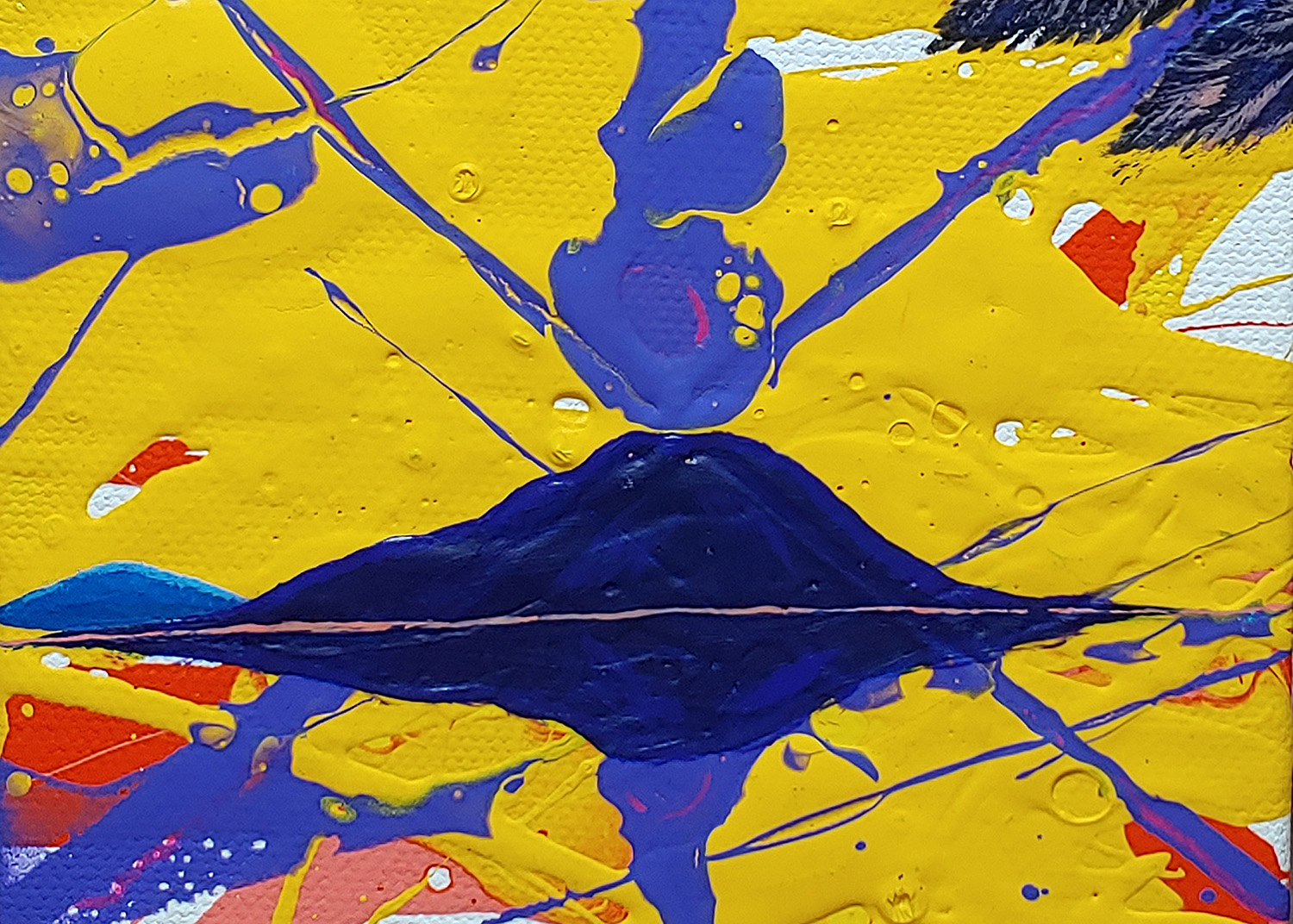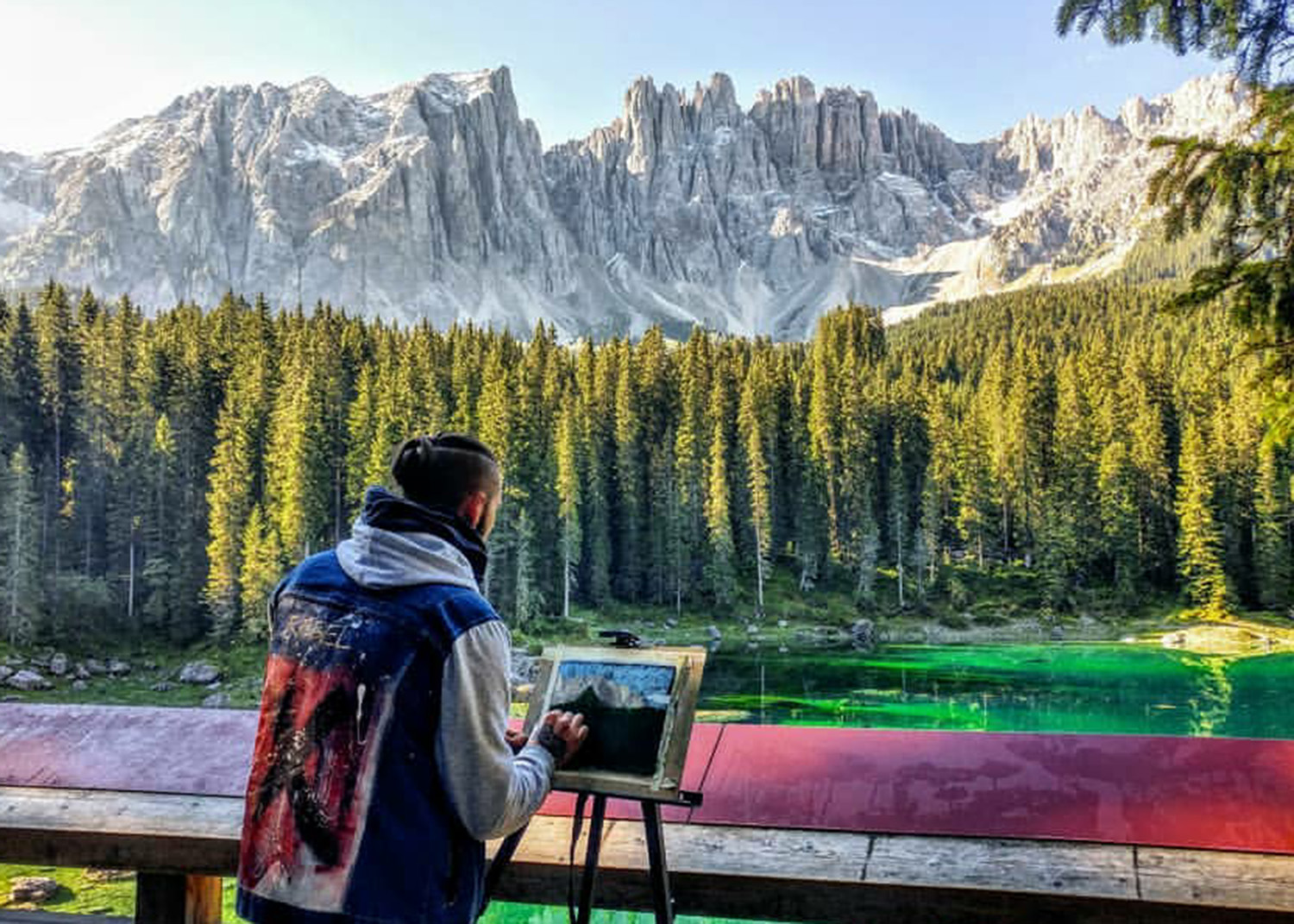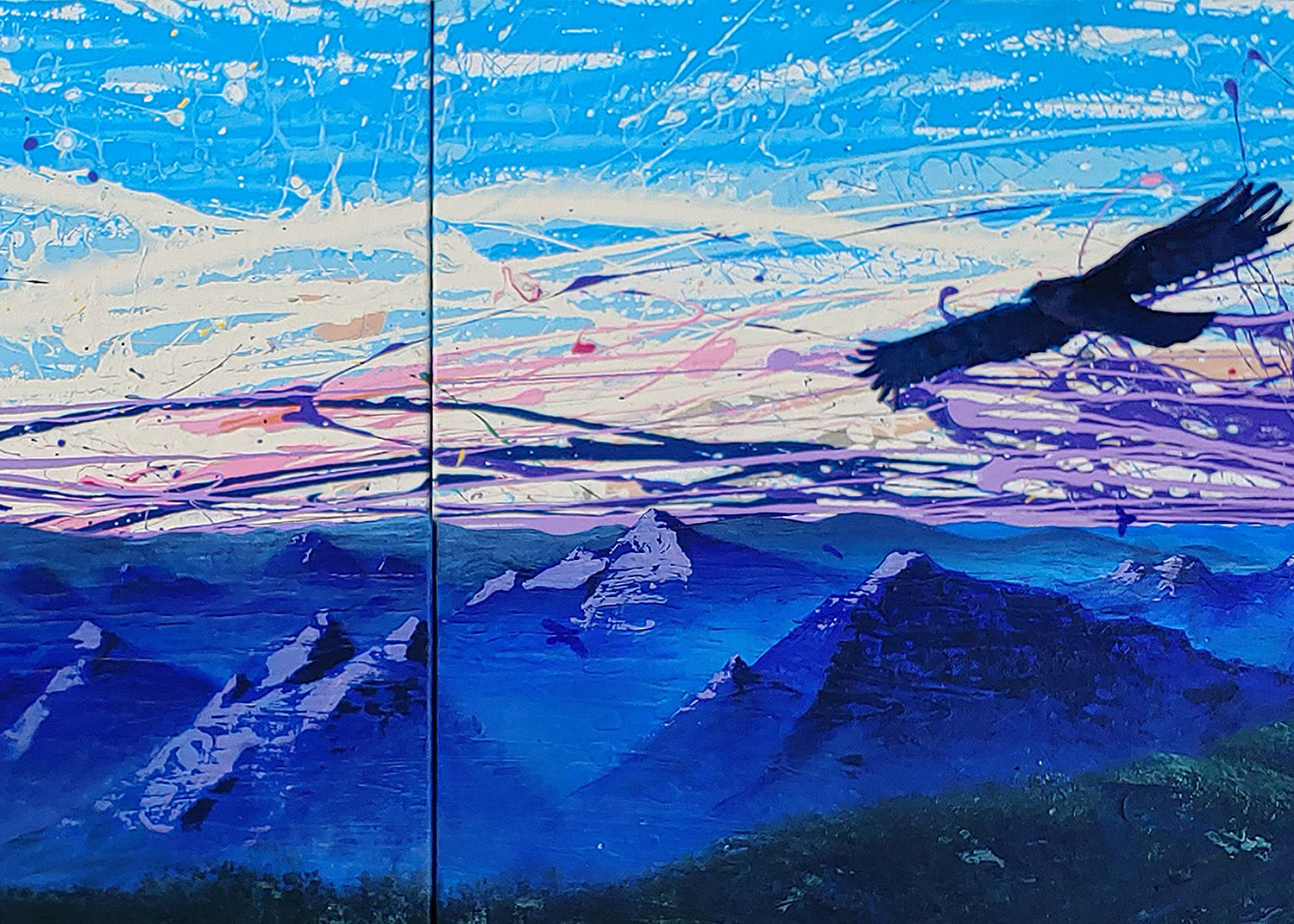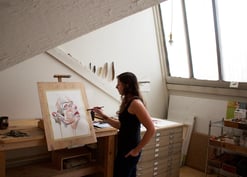Explore the artistic journey of Cody TheCreative, whose path to becoming a professional artist began with childhood sketches and evolved into a captivating exploration of emotions and nature through his vibrant collection, Splattered Skies.
With a dynamic process that involves channeling emotions onto canvas, Cody's work serves as a unique window into his subconscious, creating a visual tapestry that captures the essence of sunsets and the beauty of the natural world.
Can you tell us about your process?
I channel my emotions onto the canvas through color and intensity by throwing paint. I then let the canvas dry. If something in the abstract jumps at me immediately, I take a photo of it and upload it to the computer, so I can begin superimposing composite images onto the digital canvas in Photoshop. For example, if I see a mountain range, I either paint one in or grab a photo off the web and place it over the image of the abstract, and proceed with whatever additional imagery I envision.
Once I’ve got a mockup that I like, I head back to the canvas with my reference image and start painting. Sometimes, I reverse engineer this process by starting with an image - say a photo I took of a sunset one night, or if I know I’m going to be exhibiting in a particular city, I may find images that speak to me before I even throw any paint. Either way produces results I have been pleased with so far. The biggest difference is the experience for me - either letting the painting unfold naturally, or guiding it to a particular pre-planned destination.
Can you tell us about your journey to becoming a professional artist?
My journey to becoming a professional artist started at two years old, pausing VHS tapes to draw characters on the screen, as well as those appearing on album covers and baseball cards. I was the first “Artist-of-the-Month” at my elementary school (a tradition that continues to this day) and at eight years old, I had a solo exhibition in Greenburgh, NY titled Heroes and Icons.
I spent the majority of my pre-adolescent and adolescent years exploring the boundaries of my own individuality. While this began in a creative space, it ultimately took me off the art wagon and into a rebellious phase. Fortunately, after a bumpy stretch of teenage years, the stars realigned while finishing a Creative Writing degree at SUNY Purchase. I took a life-drawing course with noted visual arts professor, Roger Hendricks, as an elective, assuming it would be an easy ‘A’ that would help me complete my degree.
The next thing I knew, I became the teacher's assistant (for no credit!). Things really got interesting while taking a summer class with landscape artist, Todd J. Gordon, who provided me the tools to explore nature as a subject. Up until that time, I had only drawn people. This exploration of art through nature (or nature through art) was a revelation, and has become one of my favorite creative endeavors. Since taking that class, I haven’t looked back.

When you are looking for inspiration, what resources do you turn to?
Nature has been a major source of inspiration for me, both visually and spiritually. This is why I moved to Southern California, and consider myself incredibly lucky to be surrounded by so much diverse natural beauty.
Walk us through a typical day in your studio. What is your routine?
My days vary a lot depending on the type of work I'm doing. I tend to work in waves. I'll zone in on my paintings for a period of time and paint like I'm possessed. I'll do no painting and just spend time driving around sometimes, observing the landscape and the way the light impacts it, snapping pictures for reference. I'll draw en plein air, and source a lot of inspiration and insight from this aspect of my work. Lastly, in my periods of low inspiration/energy, I will do managerial tasks like housekeeping on my website, social media, and look for opportunities to show my work.

Finding the right rhythm to be productive can be a challenge, what advice do you have for staying productive and focused?
Make a list of everything you need to accomplish each day/week. Check items off as you go. Prioritize high importance tasks. This act of physically marking something done provides a sense of accomplishment along the ever going road of never being done.
We always have our eye on something that isn't there yet, and taking the time to acknowledge all that is there and has been done is an essential part of living a fulfilling life. It is also a big motivator to keep going. Another tip is to take breaks. Walk around the block. Watch an episode of a show you like. Whatever you have to do to keep yourself from burning out, because once you're cooked it's very difficult to find the energy and motivation to do much of anything.
What is your advice for combating creative block?
Always have something else you can pivot to. Another project. Another idea. I couldn't tell you the last time I had a creative block.

As an artist, how do you measure your success? Can you recall a specific event or milestone(s) in your career that made you feel successful?
Being a successful artist is a complex thing. On the one hand what we're talking about is successfully creating what you set out to create. To me, that is really what a successful artist is. That's the job, making art. Then on the other hand we're talking about financial success, or notoriety. This really has nothing to do with being a great artist, but more to do with being a great marketer, or salesperson, or making work that just happens to be right for the times.
That being said, there are definitely some specific moments that were validating for me as an artist: being juried into the Pastel Society of America; being featured on multiple MSG Networks commercials, being invited to exhibit as a featured artist at The Other Art Fair in LA, getting gallery representation in Laguna Beach, becoming a Florence Biennale approved artist, being hired to exhibit an installation at The Other Art Fair in Dallas, being given free wallspace at multiple art fairs around the country for installations of mine.
How do you see the art market changing? Where do you see yourself in this transition?
I am not familiar enough with the entire art market to comment on broad trends, but I have noticed through my own experience and those of my peers that large scale works are selling. I think there is so much noise nowadays, both in the physical and digital realm, that people are craving impact, and a large statement/centerpiece can certainly give them this.

What advice do you have for artists who are beginning to build their careers?
I think the first thing you need to do is find your voice. Then look for venues showing work with a similar style to yours and find a way in. As artists, so much of the time we are trying to be different, and that is great when it comes to creating the work, but in the case of exhibiting, you want to find venues that have clientele that are interested in what you do. If your work doesn’t look or feel like anything in a particular gallery, the chances of finding collectors there for the type of work you’re making are slim.
I used to be obsessed with social media, and there was a point that it was my main source for finding new clients. However, recently I have adopted an IRL approach, and it has been much more fulfilling. I would advise a combination of both, so you are not dependent on any one method for making a living. Venues change, apps change, and trends change, so being as nimble as possible puts you in the best position for adapting.
Do you consider yourself, and all artists, to be entrepreneurs? Why or why not?
I definitely consider myself an entrepreneur, and I consider any independent artist to be one as well. By definition an entrepreneur is: a person who organizes and operates a business or businesses, taking on greater than normal financial risks in order to do so. If that isn't the business model for an independent artist, I don't know what is.
Failure is an inevitable part of success in any field. Do you have advice for overcoming setbacks?
There are no failures. Only lessons. If something isn't working, that's when you make adjustments and try again. Do what you can to isolate the variables and tweak things one at a time, so that you can tell what it is that is/isn't working.

What sparked your interest in partnering with TurningArt? Has your experience with TurningArt differed from other art companies you have worked with?
I am listed on a number of online art marketplaces and so far the biggest difference between TurningArt and the rest is that they reach out to me periodically with various opportunities, reminders, etc…
It is very rare that I hear from any of the other companies I am currently listed with.
What does having your artwork in the workplace and other commercial or public spaces mean to you?
Having my work in public places allows more people to connect with it. Art's job is to make an impact and it can't do that sitting in a studio, or storage unit. The more people that get to see a work in person the better. It is a far more powerful experience than viewing art online. Sending my work out to places is like sending my hypothetical kids off to school. They are going to have their own experiences, make their own friends, and live their own lives.
To see more featured TurningArtists, return to our blog. To get Cody TheCreative's art in your space, set up a free consultation with an Art Advisor here!




.jpg?width=332&height=177&name=%E6%A9%983-2%20(1).jpg)

